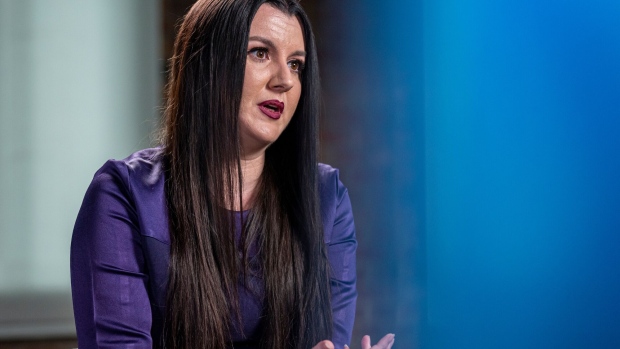Sep 19, 2023
Instacart’s IPO Puts Spotlight on Its Evolution Into Ad Seller
, Bloomberg News

(Bloomberg) -- As Instacart started trading on the Nasdaq on Tuesday, investors weren’t betting on a grocery-delivery company. They’re betting on a data and advertising business.
The company, best known for its army of gig-economy workers filling grocery orders, has spent years building up its ad division — a higher-margin operation that capitalizes on a trove of shopping data. That evolution helped add sizzle to the IPO, which priced at the top end of its marketed range Monday, and surged as much as 43% after its trading debut Tuesday. Instacart is now testing public investors’ appetite for its new model.
“Establishing themselves as a delivery channel — allowing things like product placement, marketing partnerships with consumer packaged goods companies — opens up a lot more options for Instacart as a company,” said Don Short, head of venture equity at InvestX Capital, a late-stage investor in Instacart.
The company, which is incorporated as Maplebear Inc., closed trading Tuesday up 12%, at $33.70 per share, giving it a market value of $9.3 billion.
The $660 million IPO, the fourth-largest in the US this year, promises to be a bellwether for both the food delivery industry and other startups that aim to make money off consumer data. The 11-year-old company’s progress should also give a sense of how quickly consumers will shift toward buying more of their groceries online.
Instacart’s main business involves pairing consumers with independent contractors, who go to supermarkets, drugstores and other outlets to find items. Customers pick out what they want using the app, and then the products are delivered to their door. Instacart partners with most of the big US retailers, including Walmart Inc., Kroger Co. and CVS Health Corp., to smooth the process.
But the company long intended to shift beyond that business. In 2017, the San Francisco-based startup launched Instacart Ads, allowing consumer brands to promote its products on the app with coupons. Even before that, it was promoting certain brands on the app. PepsiCo Inc., which went on to be an investor in the IPO, was already a partner back in 2016, along with Procter & Gamble Co.
Advertising now accounts for about 30% of Instacart’s revenue and offers higher margins than taking a cut of shopping purchases, according to filings. The company generated $740 million from ads and other revenue that didn’t come from shopping transactions, up 29% from the previous year.
But Instacart’s success still hinges on people doing more of their shopping online, and orders have been flat in the first half of the year. Though delivery services surged during the pandemic, most consumers still head to the supermarket to pick out their own food.
Instacart says that only 12% of grocery shopping is currently conducted online. And consumers who do try delivery apps often encounter headaches, such as the contractor having to substitute a product for something that’s out of stock.
Perfecting the experience remains a work in progress, said Fuad Hannon, a vice president who oversees grocery and convenience store delivery at Instacart rival DoorDash Inc. “A decade on, it’s still plagued with a lot of challenges,” he said. That includes having limited visibility into a store’s inventory.
Inflation also has made it harder for some consumers to justify paying a premium for delivery. And services like Instacart are competing with retailers themselves. Chains such as Walmart and Kroger have built out their online storefronts and offer services such as curbside delivery.
One trend working in Instacart’s favor: Many brands are looking to do more targeted advertising, rather than splurging on billboards or Super Bowl ads. By putting more money toward online marketplaces, including Amazon.com Inc. and Instacart, advertisers are better able to measure the impact, said Guru Hariharan, chief executive officer at CommerceIQ Inc., an ad analytics firm.
Since Fidji Simo became CEO in August 2021, the ad focus has only intensified. Instacart has expanded from sponsored products and now lets users shop directly from videos and displays in the app. There’s also the Instacart Enterprise Platform, which allows retailers to gain insights into how ad and product placements translate into transactions.
Coming over from Facebook — where she oversaw the company’s main blue social media app — Simo also struck a deal with Shopify Inc., the e-commerce platform. Shopify merchants — usually small- and medium-sized sellers — can advertise to Instacart’s audience and gain insights about their behavior.
The holy grail for any marketer is figuring out whether an ad is truly generating profits and incremental sales, said Hariharan, who works with Instacart.
“It’s a very complex data science calculation,” he said. It involves knowing how people are searching to find a product and how they’re buying it, he added.
The broader challenge is altering consumer behavior, said David Hsu, a professor who specializes in management, entrepreneurship and IPOs at the University of Pennsylvania’s Wharton School. Even if a delivery app can offer customization and feedback, it’s not yet clear to what degree consumers will embrace the technology in a post-pandemic world.
“I think they are swimming uphill,” he said.
(Updates with closing shares in fourth paragraph)
©2023 Bloomberg L.P.





